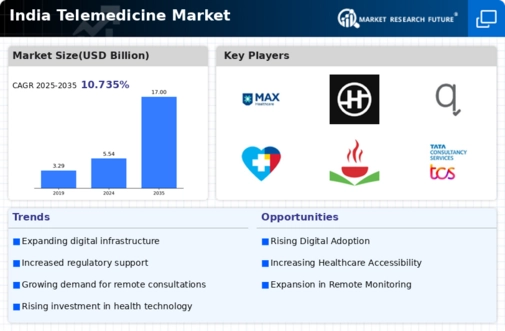Increasing Healthcare Costs
The rising costs associated with traditional healthcare services are significantly influencing the telemedicine market in India. As healthcare expenses continue to escalate, patients are seeking more affordable alternatives. Telemedicine offers a cost-effective solution, often reducing consultation fees by up to 30% compared to in-person visits. This financial incentive is particularly appealing to lower and middle-income groups, who may struggle to afford conventional healthcare. Furthermore, the telemedicine market is likely to benefit from the growing awareness of its economic advantages, as patients recognize the potential for savings on travel and time off work. As healthcare costs remain a pressing concern, the demand for telemedicine services is expected to rise, positioning the market for substantial growth in the coming years.
Focus on Preventive Healthcare
The telemedicine market in India is increasingly aligned with the growing emphasis on preventive healthcare. As awareness of health issues rises, individuals are more inclined to seek regular check-ups and health monitoring through telemedicine platforms. This shift is evidenced by a 2025 report indicating that nearly 50% of telemedicine consultations are now focused on preventive care. By leveraging telemedicine, patients can access health assessments and lifestyle advice without the need for physical visits. This proactive approach not only enhances patient engagement but also reduces the burden on healthcare facilities. Consequently, the telemedicine market is likely to expand as more individuals prioritize preventive measures, leading to a healthier population and decreased healthcare costs in the long run.
Rising Demand for Convenient Healthcare
The telemedicine market in India experiences a notable surge in demand for convenient healthcare solutions. Patients increasingly prefer remote consultations due to their busy lifestyles and the need for immediate access to medical advice. This trend is reflected in a 2025 survey indicating that approximately 70% of patients favor telemedicine for its convenience. The ability to consult healthcare professionals from the comfort of home reduces travel time and associated costs, making healthcare more accessible. Furthermore, the telemedicine market is likely to expand as urbanization continues, with more individuals seeking efficient healthcare options. This shift towards convenience is expected to drive innovation in telemedicine platforms, enhancing user experience and satisfaction. As a result, the telemedicine market is poised for significant growth, catering to the evolving preferences of the Indian population.
Technological Advancements in Healthcare
Technological advancements play a crucial role in shaping the telemedicine market in India. Innovations such as artificial intelligence, machine learning, and improved internet connectivity are transforming how healthcare services are delivered. For instance, the integration of AI in telemedicine platforms enhances diagnostic accuracy and patient management. As of 2025, it is estimated that around 60% of telemedicine providers in India utilize AI-driven tools to streamline operations. Additionally, the proliferation of smartphones and high-speed internet access facilitates seamless communication between patients and healthcare providers. This technological evolution not only improves service delivery but also fosters trust in telemedicine solutions. Consequently, the telemedicine market is likely to witness accelerated growth as these technologies become more prevalent, enabling healthcare professionals to offer high-quality services remotely.
Integration of Telemedicine in Health Insurance
The integration of telemedicine services into health insurance plans is emerging as a pivotal driver for the telemedicine market in India. Insurance providers are increasingly recognizing the value of telemedicine in enhancing patient care and reducing costs. As of 2025, it is estimated that over 40% of health insurance policies now cover telemedicine consultations, making these services more accessible to a broader audience. This trend not only encourages patients to utilize telemedicine but also incentivizes healthcare providers to adopt these technologies. The telemedicine market is likely to benefit from this integration, as it fosters a more comprehensive approach to healthcare delivery. As insurance coverage for telemedicine expands, it is expected that patient adoption will increase, further propelling the growth of the telemedicine market.





















Leave a Comment